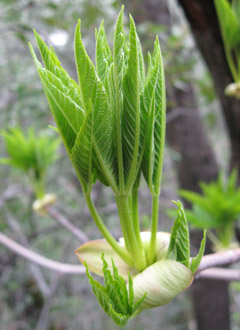General Notes
The Database
This database has been internet-searchable since 14 October 2001; new data is regularly added to the database as collecting progressed and as new specimens are added. All of our vascular plant, bryophyte, and lichen collections are included in the database, except for several long-outstanding loans and for the backlog of incoming specimens, and have been available for internet searches since 22 August 2008. Adding to the database is on-going for our collection of myxomycetes (slime molds—about 12,000 specimens) and has not yet started for our small collection of macro-algae.
Database Progress Summary - collection statistics. We are interested in your comments and suggestions—please send them to Lawrence Janeway.
The database was created in MS Access at the UC Davis Herbarium (DAV). DAV has made theUC Davis Herbarium (DAV) Database(opens in new window) freely available to the herbarium community. The database has been somewhat modified for use here at the Chico State Herbarium, but the basic structure remains intact.
Our thanks to the UC Davis Herbarium(opens in new window) for hosting the database-querying portion of our website on their web server.
Nomenclature
Nomenclature and family arrangements for vascular plants generally follows what is presented in The Jepson Manual (Hickman 1993). However, some nomenclature has already been changed to match the upcoming second edition of The Jepson Manual, especially for some genera in Asteraceae and Cyperaceae.
Family arrangements for bryophytes (mosses, liverworts, and hornworts) follows that presented for the Bryoflora of North America Project(opens in new window); however, species level nomenclature has not all been updated and may reflect only what appears on the specimen label. Nomenclature and current names for the lichens follows North American Lichen Checklist(opens in new window) by Theodore Esslinger.
Determinations
The herbarium cannot vouch for the identification of any specimens; use your own judgment and knowledge of particular collectors and determiners as your guide.
Annotations
Queries will draw upon the most recent annotations on each specimen, although the full database does contain the name originally applied to a specimen and all subsequent annotations. Vascular plants not already determined or annotated with the "current name" (according to The Jepson Manual) have been anonymously annotated by the herbarium staff to the current name. Only California vascular plant collections are being systematically referenced this way.
Data Entry
Label information has been copied as exactly as possible into the database. The only changes made during data entry are minor corrections such as obvious typos and spelling errors, especially in the plant names.
Georeferencing
Volunteer Bill Carlson has been determining latitude and longitude for our specimens that don't already have this information on their original specimen labels. This information is then added to the database records. The database contains a field that shows which records have thus had latitude and longitude added and which contained this information on their original labels. All latitude and longitude coordinates looked up by Bill Carlson or as part of other herbarium activities are in NAD 1983. Projection (NAD 1927, NAD 1983, or WGS 1984) for coordinates on original specimen labels is usually not known, but is recorded in the database when present. More information about how latitude and longitude have been determined will added here later. To date, Bill has determined latitude and longitude for more than 36,000 specimens (although 6,000 of those have not yet been entered into the database).

